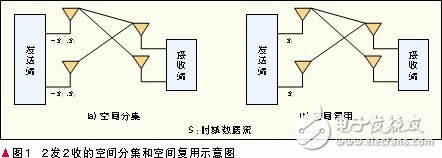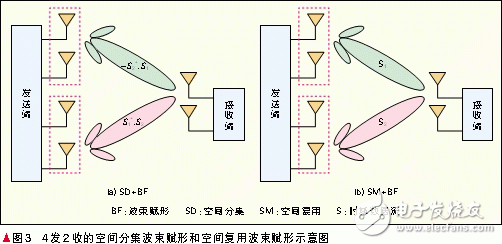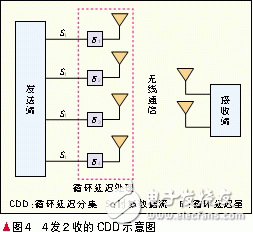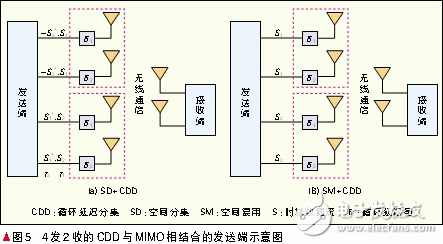Multi-antenna technology refers to wireless communication technology that uses multiple antennas at the transmitting end or the receiving end, and is one of the hot research technologies that have recently developed rapidly. Multi-antenna technology can be used to obtain power gain, spatial diversity gain, spatial multiplexing gain, array gain and interference suppression gain [1], so that the coverage and link of the system can be improved without significantly increasing the cost of the wireless communication system. Stability and system transfer rate. Multi-antenna techniques have different implementation modes, such as beamforming [2], cyclic delay diversity [3], spatial diversity [4-6], spatial multiplexing [7], and the combination between them.
1 Multi-antenna technology mode introductionEach multi-antenna technology mode has its own characteristics, and their principles and features are detailed below.
(1) Space diversity technology
Spatial diversity is the introduction of signal redundancy in space to achieve diversity. As shown in the spatial diversity in Figure 1, the transmitting end obtains the diversity gain by transmitting orthogonal sets of information at two times of the two antennas.

(2) Spatial multiplexing technology
Spatial multiplexing is to transmit different information on the same time-frequency resource on each antenna to achieve the purpose of multiplying the spectrum efficiency without increasing the spectrum resources, as shown in the spatial multiplexing in FIG. Space diversity and spatial multiplexing techniques are often referred to as multiple input multiple output (MIMO) techniques.
(3) Beamforming technology
Beamforming (BF) is a technique based on the principle of adaptive antenna, which uses an antenna array to perform weighting processing on each physical antenna by an advanced signal processing algorithm. As shown in FIG. 2, the transmitting end weights the data stream S1 and transmits it. From the perspective of the receiving end, the entire antenna array is equivalent to a virtual antenna. After the weighting process, the antenna array forms a narrow transmit beam to align with the target receiving end, and forms a zero point in the direction of the interference receiving end to reduce interference.

(4) MIMO+BF technology
Since the BF technique transmits only one data stream at a time, there is no multiplexing gain. Especially when the channel quality is good, the transmission rate increase caused by using BF is not obvious. Therefore, in order to further increase the system transmission rate, BF technology can be combined with MIMO [8-9]. The combination of spatial diversity and beamforming is called spatial diversity beamforming (SD+BF); and the combination of spatial multiplexing and beamforming is called multiplex beamforming (SM+BF). One of the implementations is shown in Figure 3. The four physical antennas on the transmitting end are divided into two sub-arrays, and each of the sub-arrays uses beamforming technology to form a virtual antenna or beam, and two beams form spatial diversity or spatial multiplexing.

(5) Cyclic delay diversity technique
Cyclic Delay Diversity (CDD) is a multi-antenna transmit diversity scheme commonly used in Orthogonal Frequency Division Multiplexing (OFDM) [10] technology. It transmits the same frequency domain data on each physical antenna and performs OFDM in the time domain. The symbols perform different cyclic delays to obtain the frequency domain diversity gain. As shown in FIG. 4, the time domain data stream S1 is respectively transmitted on each physical antenna with a cyclic delay δi. Where δi is the amount of cyclic delay, i=1, 2, 3, 4, and δ1 is generally 0. After CDD processing, the entire antenna array is also equivalent to a virtual antenna at the receiving end.

(6) CDD + MIMO technology

Since CDD technology only transmits one data stream at the same time, when the channel conditions are better, it can be combined with MIMO technology to increase the transmission rate [11-12]. The combination of spatial diversity and cyclic delay diversity is called spatial diversity cyclic delay diversity (SD+CDD); and the combination of spatial multiplexing and cyclic delay diversity is called spatial multiplexing cyclic delay diversity (SM+CDD). One of the implementation schemes is shown in FIG. 5. The four physical antennas at the transmitting end are divided into two sub-arrays, and each sub-array is subjected to CDD processing to form a virtual antenna.
2 Multi-antenna technology comparison(1) Data transmission format
Each multi-antenna technology mode sends different data on each physical antenna. Taking the IEEE 802.16e [4] 4 antenna as an example, in the two adjacent symbols and on the same data subcarrier, the frequency domain data stream transmitted by each physical antenna is as shown in Table 1. Spatial multiplexing uses BLAST coding [7]; spatial diversity uses AlamouTI coding, which introduces redundancy between two orthogonal frequency division multiple access (OFDMA) symbols. The BF weight corresponding to the kth data subcarrier on the ith transmit antenna is wi(k), i = 1, 2, 3, 4. In addition, the cyclic delay for time domain data is equivalent to multiplying the frequency domain data by a phase rotation.
Samsung Screen Protector,Tempered Glass Samsung,Mobile Tempered Glass,Tempered Glass Screen Protector Iphone Samsung
Shenzhen TUOLI Electronic Technology Co., Ltd. , https://www.szhydrogelprotector.com